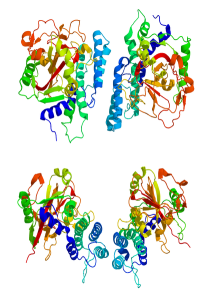Fighting womb cancer with PARP inhibitors

In the summer of 2013, mum of two, Suzanne Harford went to see the doctor after noticing unusual changes in her monthly cycle. Thinking that she might have a common non-cancerous growth called a fibroid, her GP referred her for surgery.
But three weeks after the operation, Suzanne received some devastating news: she had a rare form of womb cancer.
"The first thought was 'my girls – I can't die because I can't leave my girls, not without their mummy'," she told us. "I couldn't eat, couldn't sleep and was in a haze of disbelief. The hardest day of my life was having to tell my two beautiful daughters that their mummy had cancer."
Suzanne had to wait a further two weeks to find out whether the cancer had spread, but luckily it had been found early. She began an intensive six week course of radiotherapy, and, as she and her doctors tackled the disease, her family were at her side.
"The love of my girls, my husband, family and friends supported me through this challenging time"
In December that year, Suzanne was given the all-clear, and now she is helping us to make sure that other families can look forward to future summers together.
"The treatments I had would not be here without research. I am standing up to cancer for me and for all families who could be facing losing a parent".
Like Suzanne, many women diagnosed with womb (or 'endometrial') cancer can be cured with surgery. However, if the cancer has spread into the surrounding tissues, an operation isn't always possible.
For these women, there is no standard treatment plan, and new options are urgently needed to give them more time with their families.
With support from Stand Up To Cancer, hope is on the horizon in the form of a brand new class of drugs, known as PARP inhibitors.
Beyond repair
DNA is the instruction manual inside each of our cells, encoded in the form of genes. They tell our cells when to grow, when to die and what to do.
But these precious instructions are vulnerable to damage.

Our genetic code contains around three billion letters – that's more than 800 times as many as the complete works of Shakespeare. Most mistakes in this code don't cause significant problems – they're the equivalent of missing a full stop or space – but some errors can completely change the meaning of the instructions, or destroy them altogether.
If too many mistakes build up in the DNA of one cell, some of the instructions eventually become illegible, and this can lead to cancer.
Fortunately our cells are equipped with plenty of molecular 'toolkits' that find and repair damaged DNA. This helps to prevent errors accumulating to dangerous levels, and protects us from cancer. What's more, if the mistakes in the genetic code cannot be fixed, the cell is programmed to self-destruct, shutting down safely before any more damage can be done.
However, cancer cells manage to escape this failsafe. Instead of shutting down when the damage to their DNA becomes too great, they continue to grow and divide using a faulty set of instructions.
Researchers think that this is partly because they are still trying (unsuccessfully) to make repairs, even as they grow and divide out of control.
Not only does this mean that the cancer cells don't die, but they're also able to patch up some of the damage done by chemotherapy and radiotherapy, posing a real problem for doctors and patients.
This cell will self-destruct in five… four… three… two…
One clever way to kill cancer cells is to stop these running repairs, leaving the cells so damaged that they have no option but to die.
In the 1990s, Cancer Research UK-funded scientist Professor Steve Jackson began investigating how to do just that. He wanted to know what would happen if some of the molecules responsible for patching up DNA were switched off.
He and his team targeted cancers that already had problems with repairing mistakes in their DNA due to faults in genes called BRCA1 and BRCA2 , which Cancer Research UK scientists helped to discover. Perhaps best known for their connection with actress Angelina Jolie, these genes carry the instructions for two parts of an important DNA repair kit.
Without these repair molecules, the cancer cells survive by relying on a backup molecule known as 'PARP' (Poly-ADP-Ribose-Phosphorylase) to patch up breaks in their DNA. So Professor Jackson and his team developed molecules to block the activity of this error-fixing lifeline.
The results were impressive. Without either PARP or BRCA-based repair, the genetic mistakes in cancer cells built up to critical levels, finally tipping them over the edge, triggering self-destruction.
From the lab to the clinic
This pioneering work paved the way for the development of several new drugs that block the activity of PARP. At the end of 2014, the first of these 'PARP inhibitors', Lynparza, was licensed for use in the European Union for women with ovarian cancer caused by faults in the BRCA genes.
However, we're still waiting for them to be approved for use on the NHS – a situation that we believe urgently needs to change.
Since then, PARP inhibitors have shown real promise in trials for other cancers caused by faulty DNA-repair machinery. And with support from Stand Up to Cancer, Dr Rebecca Kristeleit at University College London wants to find out whether they could help women with advanced womb cancer.
Many womb cancers contain faults in the genes that encode components of their DNA repair toolkits, and since the end of 2014, Dr Kristeleit and her team have been making preparations for a clinical trial to test a new PARP inhibitor in women with the disease.
Each of the 80 patients on the trial will have her cancer genetically tested to find out whether key components for DNA repair have been damaged. This will allow the team to see whether specific faults make some womb cancer cells more vulnerable to PARP inhibitors than others.
This trial will provide vital information about how different tumours respond to PARP inhibitors, and could lead to new targeted treatments for women with advanced cancer that has spread through the body.
And, as there is no standard treatment available for womb cancer that has spread, the results of this trial have the potential to change the lives of many women.
That's something worth standing up for.
















